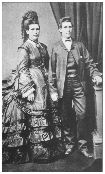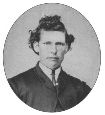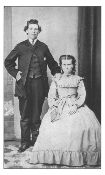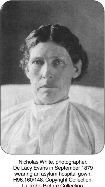The Mysterious Edward/Ellen De Lacy Evans
The Picaresque in Real Life
The La Trobe Picture Collection holds eight photographs of Edward De Lacy Evans in its Copyright Collection. All were registered in September 1879 by two photographers to meet the expected demand when a scandal broke about this individual. It was revealed in the Bendigo newspapers that Edward De Lacy Evans, champion ploughman, mining captain, married man and father was really a woman.
In the novel
Such is Life Joseph Furphy's character ‘Tom Collins’ refers to ‘one of those De Lacy Evanses we often read of in novels’, as a local generic term for a crossdressing woman. The obtuse Collins character also seems to equate De Lacy Evans with the Chevalier d'Eon, a French male who often wore female attire at the court of Louis XVI. Both of these references apply to the effeminate character whose clothes the naked Tom Collins tries to steal.
1 One can speculate about which novels Collins had in mind. John Barnes suggests that the ‘Tasma’ story, ‘Monsieur Caloche’, about a young woman passing as a man, might be an influence.
2 Further, could Furphy, or his French-speaking wife, Leonie, have read Theophile Gautier's 1835 novel,
Mademoiselle de Maupin? This dealt with a French female aristocrat who often dressed as a man and had all sorts of sexual adventures with both women and men.
Writing in the 1890s Furphy would have been familiar with the 1879 Evans case from its wide press coverage
3 and knew Johanna Jorgensen, another woman who lived as a man and who had died in 1893.
4 The
Such Is Life character, ‘Nosey Alf’, is a horribly disfigured woman who has assumed a male identity. Judith Rodriguez has shown that the original of this character was German-born Johanna Jorgensen who felt unable to live as a woman after she had been disfigured by a kick in the face by a horse.
5 In 1873, at Heathcote, Victoria, Jorgensen had been charged with wearing male attire but was released with a caution. Moving to another district, she again assumed a male identity becoming a selector, and when this venture failed was employed in general farm work. As a man she became a respected member of the Elmore detachment of the Victorian Mounted Rifles. A high-pitched voice had caused ‘a somewhat vague suspicion in regard to the sex’ of this person. When she died alone in a labourers’ hut in 1893 the doctor reported that the body was that of a ‘perfect woman’ but had to add that the body was not ‘nobly planned'.
6 Would he have made such a comment after a post mortem on a male?
More recently an Italian immigrant, Eugenia Fallini, lived as a man for years, ‘married’ and was convicted of her ‘wife's’ murder in Sydney in the 1920s.
7 Then there was SP bookmaker ‘Bill’ Edwards otherwise known as Marion Edwards, who
60
scandalised Melbourne in 1906 when tried for burglary and found to be a female. She had a short-lived ‘marriage’ with a widow and lived into the 1950s as an ‘old gentleman’ in North Melbourne.
8Perhaps the most interesting and mysterious of these women was Ellen Tremayne, or Tremaye,
9 who as Edward De Lacy Evans gained notoriety in Victoria in 1879. The Evans case attracted many lurid reports in colonial and international newspapers and sensationalist pamphlets with headlines such as ‘Extraordinary Personation Case’ or ‘The Impersonation Case'. People who claimed to have known her in Ireland or on the immigrant ship, the
Ocean Monarch, came forward with hearsay and gossip trying to unravel the ‘mystery’ of this woman's life. I have done some further ‘unraveling’ by checking, where possible, the public record to verify or disprove the evidence. However, even the public record is subject to inconsistency and confusion. For example, the ages given for her in the shipping lists and marriage and death certificates pertaining to Evans arrive at birth dates that vary from 1829 to 1841. Whether by accident or design her life remains mysterious. We may never know her real name or birth date. Indeed, the biography of De Lacy Evans is as ‘picaresque’ as anything in Furphy's novel.
Like ‘Jack’ Jorgensen, De Lacy Evans lived a large part of her life as a labourer. When her gender was discovered by the authorities she was persuaded to exhibit herself as an oddity at sideshows.
She may have been a transsexual, or gender dysphoric, that is, a person who felt herself to be male, despite being anatomically female. Today she might have had surgery and hormone treatment to arrive at gender comfort.
10 On the other hand she might have been lesbian, preferring sex with women and using male garb as a way of surviving in an ostensibly ‘moral’ and heterosexual society. The newspapers treated such women mercilessly. The various accounts of her life show that Evans was unable to cope psychologically with circumstances both before her ‘masquerade’ and after her discovery.
Evans, or Ellen Tremayne, as she was known on the ship, arrived in Australia as an assisted immigrant in June 1856. According to the Shipping Lists she was from Kilkenny, 26 years old, was Roman Catholic, could read and write and was described as a housemaid.
11 If we can believe the confused and often contradictory reports that appeared in 1879, when the ‘scandal’ broke, she had borne an illegitimate child in Ireland and fled to America. She is supposed to have returned to Ireland but was again forced by social disapproval of her ‘immoral’ life to sail to Australia by the
Ocean Monarch.During the voyage she caused much speculation on varying counts. She wore a man's shirt and trousers under her dress and seemed to have formed sexual attachments to some of her female cabin mates, in particular, Mary Delahunty, a 34-year-old governess
12 who came from the same part of Ireland, the Harristown-Waterford region. Some of her fellow passengers thought Evans was a man masquerading as a woman!
13Soon after arrival Evans, or Tremayne, as she was then known, was employed as a maidservant at a Melton public house.
14 After some time she left this position,
61
62
donned men's clothes, found Mary Delahunty and, calling herself Edmund De Lacy, ‘married’ Delahunty at St Francis’ Roman Catholic church in Lonsdale Street, Melbourne. There is evidence, however, that they ‘did not live comfortably together'. Delahunty opened a school in Blackwood and around 1862 left to marry Lyman Oatman Hart, an American mining surveyor in Daylesford.
15What of the name De Lacy Evans? During the 1850s it was a famous one. General Sir George De Lacy Evans was a prominent military man at the Crimean War and part of the Irish establishment.
16 Evans's ‘third wife’, Julia Marquand, stated that Evans had told her that the general was his uncle. Further, it was reported that Ellen Tremayne had a cabin trunk marked with the words ‘Edward De Lacy Evans'.
17 A woman who claimed to have been a Kilkenny neighbour told the newspapers that Evans was really Ellen Lacy, daughter of a well-to-do farmer of Harristown, Kilkenny, who had borne an illegitimate child and fled to North America. She returned as Mrs De Lacy Evans and was last remembered in the early 1850s as causing a furore when she rode her horse among the villagers at a gathering held by the Earl of Bessborough. The locals drove her out of town as an immoral woman.
18 There is speculation in the
Man-Woman pamphlet that her husband or paramour was named Edward De Lacy Evans, that he somehow tricked her by placing his trunk on the
Ocean Monarch but had deserted her. A man of that name is supposed to have arrived in Melbourne in June 1858 on the
Matoaka, ‘a rather handsome young fellow, well developed and with fine-flowing whiskers’ who worked as labourer around Ballarat and Bendigo.
19During the next 20 years Evans ‘married’ two other women: Sarah Moore, who died of pulmonary tuberculosis in 1867, and Julia Marquand of Bendigo.
20 Evans worked as a carter, miner, blacksmith and ploughman in the Blackwood, Bendigo and Stawell districts. During this time it seems that Evans was charged at the police court and jailed for seven days for being found in a servant's bedroom at the hotel where she and her ‘wife’ Sarah worked, but got away with swindling a fellow miner out of £175.
21 Nevertheless, the public record shows her as owning shares in various goldmines and paying rates for properties in Eaglehawk and Sandhurst.
22When her third ‘wife’, Julia Marquand, gave birth to a child in March 1878 Evans registered herself as the father. Perhaps in a certain sense, we can see Evans as the embodiment of feminist Julia Kristeva's theories of the ‘abject mother’ and the ‘imaginary father'. In the early 1850s Evans, as Ellen Tremaye, had borne a child and become outcast from her own region; now in 1878, by registering the child as her own in her masculine persona, she becomes a ‘father'.
Evans and Julia Marquand seem to have lived together only intermittently, Evans working in Stawell or Ballarat and Marquand working as a dressmaker near the City Family Hotel,
23 owned by Marquand's brother-in-law Jean Baptiste Loridan. There must, however, have been deep resentments following on the discovery of her ‘wife's’ pregnancy. In July 1879, she became violent to Julia and the 15-month-old daughter, fell into deep depression and was admitted to the Lunacy Ward of the Bendigo Hospital suffering from ‘amentia'.
24 For the next six weeks she refused to bathe, and it was not until she was removed to the Kew Asylum and forcibly
63
stripped, that her gender was discovered.
25 She was promptly handed over to female nurses and dressed in ‘frocks and petticoats'.
26 Bendigo newspapers reported the story with much prurient and salacious detail. Soon, the colonial and international press ran the stories
27When the De Lacy Evans ‘scandal’ broke, Aaron Flegeltaub, a Stawell photographer, exploited the situation bringing to light ‘excellent likenesses’ of Evans and Julia Marquand taken about 1870. He possibly made a tidy sum selling them as
cartes-de-visite.
28 Bendigo photographer Nicholas White somehow obtained access to Evans just after she had been readmitted to the Bendigo Lunacy ward,
29 and took a trick photograph of her dressed in both male and female clothing.
30 He also took a series of head and shoulders portraits of Evans wearing what seems to be a white hospital nightshirt (or straight-jacket). White's action seems a clear case of exploitation.
31 In the photographs Evans stares out at us, wild eyed and probably affronted by the intrusion. The Australian Medical Journal of 15 April 1880 gave a detailed description of another intrusion: a gynaecological examination that caused her to cry and scream while Dr Penfold used his speculum. This report, however, verifies that Evans was physiologically female and that she had carried and borne a child.
32Not surprisingly the existence of a child and the ‘wife's’ insistence that she did not know that Evans was a woman caused most public conjecture. Speaking to reporters, Julia Marquand ingenuously accounted for the child by saying that she believed that ‘some strange man entered the house one night about the time her husband should have returned home'.
33 There was evidence that the second wife, Sarah Moore, after about a year of marriage, was aware of the masquerade and not happy with the situation. A witness reported Moore punching Evans on the breast, her ‘weak place'.
34 While Marquand might not have been aware of Evans's gender, it is likely that she nevertheless had sought sexual gratification with her brother-in-law.
After her release from Kew Asylum, Evans, dressed as a woman and still mentally distressed, was a witness at Julia Marquand's paternity suit against her brother-in-law Jean Baptiste Loridan, a prosperous Bendigo businessman, married to Marquand's sister, and father of four children.
35 Evans gave the only corroborative evidence in the case stating that she’ had seen them in bed together. But her evidence, given in an incoherent manner, was not accepted and the case was dismissed.
36 The scandal and business problems led to the ruin of Loridan's career in Bendigo and he left for Queensland where he was involved in the start of the sugarcane industry.
37The furore of the De Lacy Evans case caused entertainment entrepreneurs to apply to the Bendigo Hospital for permission for her to be ‘publicly exhibited'. Samuel Lazar of Sydney offered £3 and £5 per week for a tour. To their credit, the Asylum authorities refused the offers.
38 Nevertheless, after her release from the hospital in December 1879 Evans was being exhibited by panorama showmen at Geelong and Stawell. Here local newspapers contrasted her ‘strange unfeminine liking’ for hard work with her appearance in the show, ‘…neither mind nor body possesses the vigour once so noticeable … the rival of the other sex in physical and
64
mental ability is now weakly and half-witted.'
39 The story had been noticed in the theatre world. The comedian Mr Greville incorporated it into his act at the Theatre Royal:
And now comes the news that our friend Mr Lansell
Is winning his gold with the help of a dam-sell.
40
She also appeared in Melbourne at St Georges Hall, Bourke Street, in January 1880 billed as ‘The Wonderful Male Impersonator'.
41 In September 1880 at Sydney's Egyptian Hall, a ‘down market’ music hall in George Street, she shared billing with a trapeze artist and ‘The Electric Boy’ at a similar show.
42 It was about this time, 1880, that the pamphlet,
The Man-Woman Mystery, was published, probably to be sold at the shows.
43 She who had acted as a male for nearly 25 years, was not a success in showbusiness. By February 1881 she was applying for relief at the Melbourne Police Court, asking to be admitted to the Benevolent Asylum.
44Tremayne died in August 1901 in the Melbourne Immigrants’ Home, St Kilda Road, Melbourne, where she had been an inmate since February 1881.
45 A report in the
Weekly Times in 1895 describes her as a sad figure, working in the Home garden, ‘dressed in female garb'.
46The voyeuristic attitude of the press and its readers is particularly interesting. The
Bendigo Advertiser boasted of a clamour from readers for 1,000 extra copies of the issue devoted to the De Lacy Evans case and published a special
Supplement devoted to the ‘Extraordinary Case of Concealment of Sex'.
47Researchers with a knowledge of Australian newspapers of the time will know that while some sections of articles could be extremely coy, if there was the possibility of titillation, reporters generally called a spade a spade. When reporting the De Lacy Evans case, for instance, the newspaper reports mentioned ‘nymphomania’ as a cause of her behaviour: ‘It is evident … that the woman must have been mad on the subject of sex from the time she left Ireland dressed as a woman.'
48 They made special mention of how her breasts had developed since she had worn female clothing!
The wonderful alteration in her appearance during the fortnight she had been in hospital seems really magical. She has become altogether effeminised, and it is difficult to believe now that so womanly-looking an individual could ever have passed for a man. Her breasts have almost regained their normal condition; the wrinkles in her face have disappeared, her arms are becoming fleshy, and the scars and marks on them being eradicated.
49As we can see in the photographs Evans did not look particularly masculine. She was only 160 cm in height, her voice was light and she had no beard. It was reported that her fellow miners referred to her as ‘the old woman’, so it is possible that there was unspoken knowledge of her true gender. There is only one main interview that quotes her directly, even laughing. From this we can get an idea of her speaking in a light brogue but always secretive. Here she describes her journey and arrival at Kew:
65
I was sittin’ the carriage at the railway station, an’ the wife was cryin’ and the kid was squealin’, an’ I was laughin’ at ‘em. Well, when we got to Kew, the fellers there took hold o’ me to give me a bath, an’ they stripped me to put me in the water, an’ then they saw the mistake. One feller ran off as if he was frightened; the others looked thunderstruck an’ couldn't speak. I was handed over to the women, and they dressed me up in frocks and petticoats.
50Uncomfortable in female dress in the asylum Evans attacked a male visitor trying unsuccessfully to steal his clothes — rather like the incident when Furphy's Tom Collins tried to steal the clothes of the ‘large fair young man’ he likened to the Chevalier d'Eon.
51There was a coyness about what we now see as probable homosexual elements in the case. Perhaps the press believed, with Queen Victoria, that female homosexuality did not exist. Or there may have been a kind of special censorship among the press, where they believed they knew the true situation, but would not speak its name.
During the De Lacy Evans case particularly, there was strong disapproval of women assuming men's roles. Throughout the reports there was a tone of amazement that women should have the effrontery to live as men. For example, as the feminine Ellen Tremayne, Evans had possibly been ill-used by men, being seduced and deserted, and bearing a child. In her persona as the hard-working masculine De Lacy Evans she lived a fairly satisfactory and adventurous life for 20 years before what she must have seen as sexual betrayal by her ‘wife’ and her subsequent mental breakdown.
Did his ‘wives’ know that Edward De Lacy Evans was female? When questioned by reporters, Julia Marquand stated that ‘he’ would never let her see ‘him’ stripped or washing himself. When Evans suffered a head injury in a mining accident she would not let the doctor examine her further.
52 A clue to how the wife was tricked is given in Suzanne Falkner's book on Eugenia Fallini,
Eugenia: A Man. Among the exhibits at Eugenia's murder trial was a kind of home-made strap-on false penis or dildo.
This might give some indication of the level of the possible sexual practices of these people. It could have been fully clothed intercourse in the dark by women largely ignorant of more uninhibited sexual practices. Clothes, of course, were vital for the maintenance of the cross dressers’ gender identity. Or, on the other hand, did the ‘wives’ take part in full knowledge that their partner was a woman. If the ‘wife’ did not know Evans's true gender, there is a question of the effect of the ‘marriages'
66
on these women, most possibly duped and disappointed in their expectations of ‘conventional’ marriage.
Suits Me: The Double Life of Billy Tipton, a recent biography of an American jazz musician of the 1940s, tells the story of a cross-dressing female whose various ‘wives’ claimed not to have known that she was a woman.
53What of the other players in this sad life story? Mary Delahunty, whose husband, Lyman Oatman Hart, became Mayor of Daylesford in 1878, seems to have made a ‘good’ marriage. They had one child, a son Lyman Delahunty Hart born in 1863. His descendants live in Melbourne. Julia Marquand, who had for years suffered from a diseased hip,
54 died at the age of 71, still in Bendigo, in 1913.
55 Her daughter, known as Julia Mary Evans, married Alfred Burtonclay in 1906 and died in 1945 in the Hospital for Mental Hygiene, Mont Park, where she had been a patient since 1942.
56 Julia Marquand's grand-son died without issue in 1960.
The story of Ellen Tremayne is an example of the lengths to which some women had to go in order to live as they wished. She gave false statements at her ‘marriages’, risked ostracism, and endured exposure to a gaping audience as a show-freak. However, dressing and living as men perhaps gave her a sense of power lacking in her female role. When her secret was discovered the press and public could not cope with the affront to society's norms and treated her with voyeuristic curiosity, which, of course, continues in this article.
Mimi Colligan
[Some of the material in this article is from my unpublished paper, ‘Cross dressing among the workers’, delivered at the Bring a Plate Conference held at University of Melbourne in 1994.]
67
68



